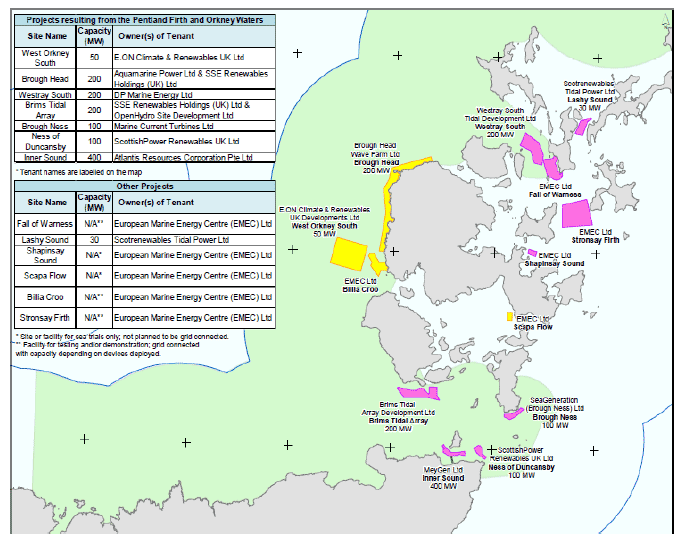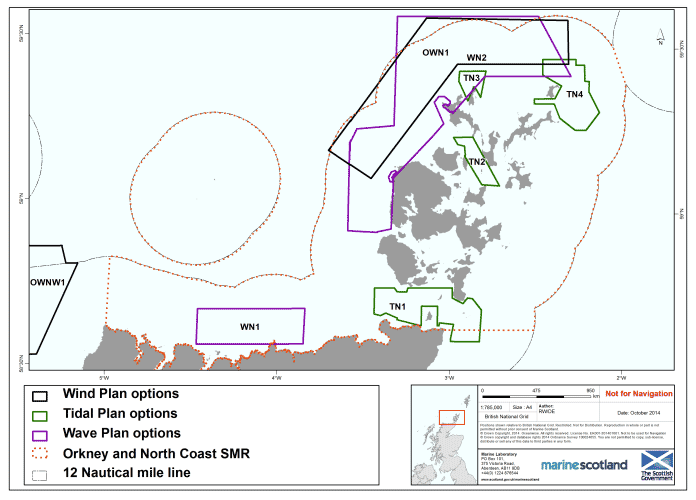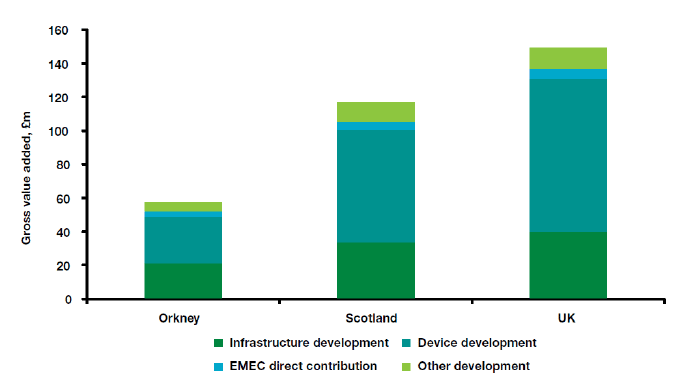Pilot Pentland Firth and Orkney Waters Marine Spatial Plan - Socio-Economic Baseline Review
This Socio-Economic Baseline Review provides a regional overview of the Pentland Firth and Orkney Waters area for the pilot Pentland Firth and Orkney Waters Marine Spatial Plan. It also informs the Sustainability Appraisal for this Plan.
9 Energy Generation
9.1 Spatial Extent and Intensity of Activity and Interests
9.1.1 Scotland and the PFOW area in particular is a leading location for the development of the offshore renewable energy industry. Scotland has tremendous wave and tidal resources off its coasts and state of the art testing facilities, such as the European Marine Energy Centre. PFOW has been identified as a region with a significant wave and tidal stream resource which has led to the first commercial leasing round for wave and tidal energy.
9.1.2 The Crown Estate has entered into Agreements for Lease for a number of projects in the PFOW, some of which are being actively progressed by the developers. This followed a competitive leasing round for demonstration and commercial scale project sites. Figure 8 shows the geographic distribution of wave and tidal projects in the PFOW. A further 30 MW project at Lashy Sound was leased in autumn 2012 for a commercial tidal demonstrator array.
Figure 8 Map of Wave and Tidal projects in PFOW [35]

9.1.3 The Blue Seas - Green Energy - A Sectoral Marine Plan for Offshore Wind Energy in Scottish Territorial Waters [36] identified one medium term area of search for offshore wind. Following review and development of the Draft Sectoral Marine Plans for Offshore Renewable Energy as part of Planning Scotland's Seas [37] the previous areas of search were refined. This resulted in a number of Plan Options being developed. Each of these represents a development zone for wind, wave and tidal energy respectively, a proportion of which could be used for development. In the PFOW area the Plan Options are: one offshore wind site ( OWN 1), two wave sites ( WN1 and WN2) and four tidal sites ( TN1, TN2, TN3 and TN4) as shown in Figure 9.
Figure 9 Offshore Wind, Wave and Tidal Energy Plan Options - North Region [37]

9.2 Economic value and employment
9.2.1 The Crown Estate has committed to invest and manage £5.7 million in an Enabling Actions fund for project development in the PFOW. Its aim is to accelerate and de-risk the development of the wave and tidal projects in the Pentland Firth and Orkney waters and facilitate the successful and timely construction and operation.
9.2.2 £23 million has been invested by Orkney Islands Council and Highlands and Islands Enterprise in supporting infrastructure for the marine energy sector.
9.2.3 The European Marine Energy Centre ( EMEC) was established in 2003 to provide developers of both wave and tidal energy converters with purpose-built, accredited open-sea testing facilities. Located in Orkney, EMEC has access to the excellent wave regime, strong tidal currents, grid connection, sheltered harbour facilities and the renewable, maritime and environmental expertise that exists within the local community.
9.2.4 Many of EMEC's clients are technology developers with an Agreement for Lease with the Crown Estate for developments in the PFOW. With 14 full-scale test berths, there have been more grid-connected marine energy converters deployed at EMEC than any other single site in the world, with developers attracted from around the globe. These developers use the facilities to prove what is achievable in some of the harshest marine environments, while in close proximity to sheltered waters and harbours.
9.2.5 EMEC was founded with public money, to date receiving £36 million, and has been self-supporting since 2010. The investment attracted to Orkney alone by EMEC has far exceeded the initial investment in establishing the facilities and, when the entire UK is considered, the gross value added to the economy has been calculated to be 4.5 times the initial investment cost. Renewable UK reports that GVA into the economy associated with EMEC to the end of 2011 was £149 million (Figure 10) [38] .
Figure 10 Economic Impact of EMEC, 2003 - 2012 [38]

9.2.6 EMEC employs 27 staff directly and approximately 300 people are employed in Orkney in the marine renewables sector in around 40 different local companies. It has attracted developers from all around the globe. EMEC has become a centre of expertise and is at the forefront of the development of international standards for the testing of marine technologies. EMEC has established a number of international collaborations with organisations in Canada, China, Japan, USA, South Korea, Taiwan and work closely with entities in Chile and New Zealand.
9.2.7 EMEC has created employment and expertise in Orkney and is a hub for wave and tidal energy in the UK, Europe and Worldwide.
9.2.8 In July 2014, EMEC was awarded the seabed rights for a new demonstration site in the Stronsay Firth, south east of EMEC's existing tidal test site at the Falls of Warness, and will offer additional testing facilities for tidal energy devices, components, subsystems, arrays and array enabling technology.
9.2.9 The Pentland Firth and Orkney Waters Marine Energy Park which was launched in 2012 to offer a coherent, supportive business environment designed to accelerate the commercialisation of wave and tidal stream technologies. The PFOW Marine Energy Park is the first marine energy park in Scotland and the second in the UK. The park designation was designed to link university researchers (including those at Heriot Watt International Centre for Island Technology in Stromness and the Environmental Research Institute in Thurso) and private companies working in marine energy.
The Crown Estate Lease Sites
9.2.10 Table 22 provides a summary of the current status of The Crown Estate wave and tidal lease sites in the PFOW area.
9.3 Data Gaps and Limitations
9.3.1 Given the level of activity within the PFOW area there is a wealth of economic information available. The main limitation of the data involves the uncertainty attached to future projections of offshore renewable projects as their success relies on many factors including the continued improvement of wave and tidal technology.
Table 22 Wave and Tidal lease sites in the PFOW [39]
| Site Name | Development Type | Lease Capacity ( MW) | Planned Capacity ( MW) | Jobs | |
|---|---|---|---|---|---|
| Farr Point | Wave | 50 | 10 MW | Operational: 16 Construction: 200+ | |
| West Orkney South | Wave | 50 | Scoping | Consenting applications under development (2014) | |
| West Orkney Middle South | Wave | 50 | Scoping | Phase 1: 10 MW | |
| Marwick Head | Wave | 50 | Scoping Stage/Consenting | Phase 1: 10 MW | |
| Brough Head | Wave | 200 | Scoping Stage/Consenting | Phase 1: 9 MW. Phase 2: up to 50 MW | |
| Costa Head | Wave | 200 | 10 MW | Phase 1: 30 - 50 MW | |
| Westray South | Tidal | 200 | 60 MW | Phase 1: 60 MW. Phase 2: 140 MW | |
| Brims Tidal Array (previously Cantick Head) | Tidal | 200 | Currently in scoping and consenting phase | Consent application | |
| Brough Ness | Tidal | 100 | 66 SeaGen devices (99 MW) | First turbines expected in 2019 | |
| Ness of Duncansby | Tidal | 100 | Scoping Stage - 95 x 1 MW | Planning and consent 2015. Construction 2016. Phase 1 deployment 2017 | |
| Inner Sound | Tidal | 400 | 4 MW (2015) | Phase 1: 30 MW. Further 65 MW | Current Staff: ~20 |
| Lashy Sound | Tidal | 30 | 10 MW (2017) | 86 MW (2016). 398 MW (2020) | Current Staff: 9 |
Contact
There is a problem
Thanks for your feedback